Expedition to the ancestors. New migrations of ancient peoples
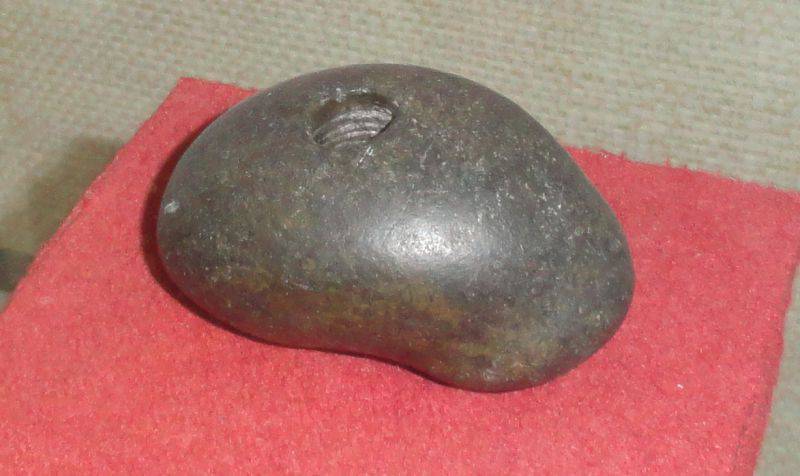
Mace from the local history museum in Pyatigorsk. Photo by the author
showing them the way, and at night in a pillar of fire,
giving light to them, that they may go day and night.
Book of Exodus 13:21–22
And now the commander called them to him.
Sing a song, sing.
“One of you will go to the West,
To the Far East is different.”
The friends smiled. Well! Trifle
Sing a song, sing.
“I’m tired of you,” one said.
“And you to me,” said the other.
The play "Glory". V. Gusev
Migrants and migrations. We don't know how or how it ended story those who lived in Gobekli Tepe and in other places marked on the map given here. Looking at it, you can immediately understand that the “big center”, which was Gobekli Tepe, also had peripheral, “small centers” of a similar culture, and that the area that it somehow covered was quite large.
And the question is: did this culture disappear due to some natural reasons, did it transform into something new, or did its bearers migrate to some other areas?
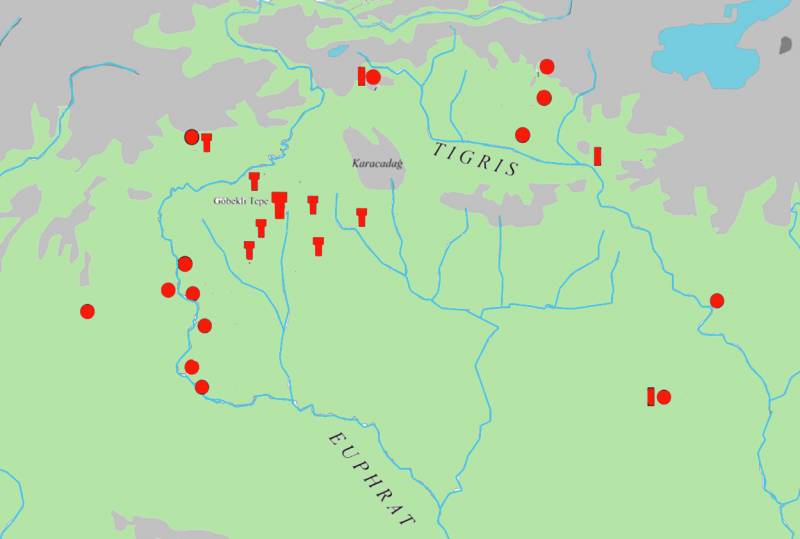
Gobekli Tepe cultural centers: big “T” - Gobekli Tepe; small “t” – similar buildings. “Circles” are round stone buildings. Vertical lines “I” – stone pillars. Rice. A. Shepsa
One of the previous materials also discussed the fact that the spread of agriculture in Western Europe was associated not so much with population migrations from Asia, but with contacts of aborigines who learned advanced agricultural methods from each other. But…
No one completely denies the presence and fact of migration. That is, all those thousands of years that the inhabitants of the same Gobekli Tepe built their temples, in some other areas people moved from one place to another, walking not hundreds, but even thousands of kilometers.
Moreover, it was at this same time that the so-called Proto-Indo-Europeans appeared. But, as it turned out, they have so many roots that it’s simply impossible to tell about them all in detail, but the main hypotheses about where they came from can and should be told, especially since with our Asian settlements, for example, the same Çatalhöyük, some of them are closely connected.
So, today we will talk about the homeland of the Proto-Indo-Europeans, that is, where, simply put, they came from.
When a hypothesis drives a hypothesis...
VO readers love to look for those to blame for the fact that some of the mysteries of history are not revealed the way they would like. And they blame for this... historians who do not allow other historians to “discover the truth”, officials who do not allow an analysis of the stones from which the Egyptian pyramids are made, in a word – “certain dark forces”, of which there are a dime a dozen around us.
In fact, this is not so: if you have evidence, put forward any theory, even if it may discredit someone. Everyone will only be happy about something new, as long as it stands on a solid foundation. And the fact that there are a lot of theories explaining the origin of the Indo-Europeans is the best proof of this. If I found at least something, I immediately came up with a new theory, but what? Others can, but I can’t!
Therefore, one should not be surprised that today there are many theories, of which the “kurgan hypothesis,” which appeared back in 1956, is the most widespread. She calls the Volga and Black Sea steppes the ancestral homeland of the Indo-Europeans, where cultures such as Samara, Sredny Stog, Khvalyn and Yamnaya arose and developed.
Moreover, having appeared in one place (it is believed that this happened as a result of a mutation that gave strong and viable offspring!) place, the great-great-ancestors of modern Indo-Europeans first of all began to migrate to the south, west, east and north of their ancestral home. The ancestors of the Baltic peoples and Slavs occupied the original area for the longest time.
Why is this version the most common?
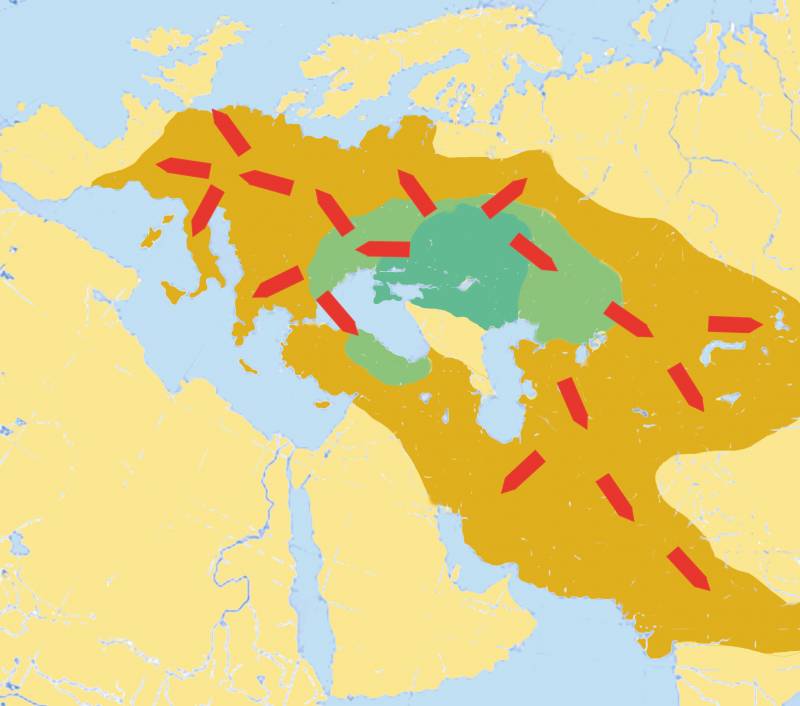
Map of the distribution of Proto-Indo-European tribes in accordance with the “kurgan hypothesis”. Rice. A. Shepsa
Yes, simply because it is the easiest to confirm! I found a mound - large or small, dug it up, discovered a burial, and in it the corresponding grave goods - that's all, it means that they lived here.
There is a Baltic-Black Sea hypothesis, the essence of which is that already in the Mesolithic (8500–5000 BC), Proto-Indo-Europeans lived in vast territories between the Black and Baltic seas.
The Balkan hypothesis moves the ancestral home of the Proto-Indo-Europeans to Central Europe and the Balkan Peninsula, identifying their culture with the culture of the tribes that made linear-band ceramics.
The Anatolian hypothesis is also very interesting, which calls Çatalhöyük a settlement of Indo-Europeans, and claims that it was its inhabitants who migrated from Anatolia to South-Eastern Europe.
And these are archaeological cultures that, according to researchers, belong to the Proto-Indo-Europeans:
Grebenikov culture (7000–5500 BC);
Çatalhöyük culture (6800–5500 BC);
Bug-Dniester culture (5500–4800 BC);
Starcevo-Krisha culture (5000–4500 BC);
Crimean culture (4900–3400 BC);
Sur-Dnieper culture (4900–3800 BC);
Azov culture (4900–4500 BC);
Linear Band Ware culture (4500–4000 BC);
Vinca culture (4400–3500 BC);
Boyan culture (4390–4100 BC);
Dnieper-Donetsk culture (early stage) (4200–3800 BC);
Gumelnitsa culture (4000–3000 BC);
Lengyel culture (4000–2700 BC);
Trypillian culture (IV–II millennium BC).
Oh, if only culture spread consistently...
That is, wherever you dig in all these areas, you will find Proto-Indo-European culture. And they all differed from each other in some way, but also had a number of common features. And this, by the way, is much more interesting than the “buried stones” of Gobekli Tepe.
Why did the cultures of ancient peoples living close to each other differ from each other? And often very significantly!
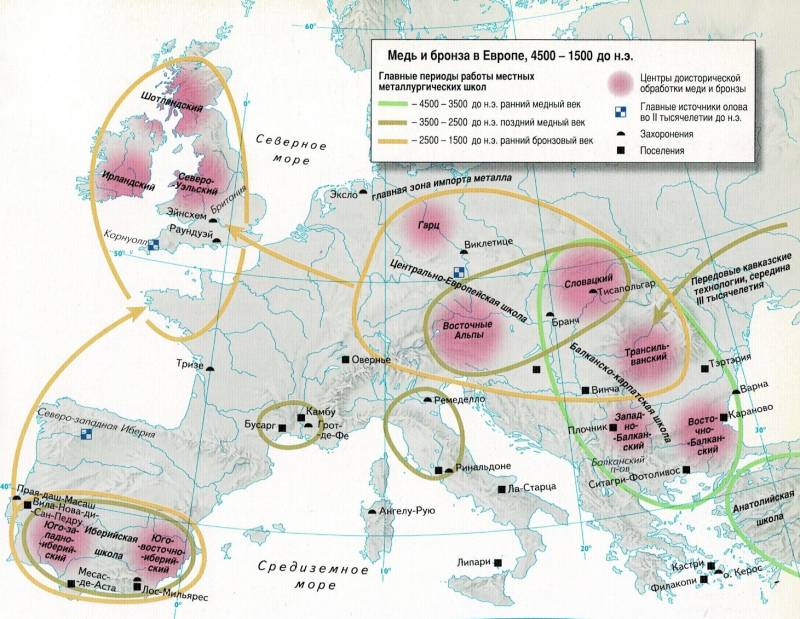
And this is how copper and bronze spread in Western Europe...
How much simpler our history would be if cultural changes spread in waves and successively replaced each other. That is, in one place, a fashion arose for pots decorated with ribbon ornaments and... People began to adopt them from each other, and after some time we find such pots everywhere, and the radiocarbon method of dating the remains of carbon-containing materials would show us the time of that or another pot. Then we could accurately determine the speed of migration of the carriers of a particular culture, or... the speed of the spread of fashion for certain pots.
But what is not there is not there. Our distant ancestors did not want to copy their neighbors in everything, and by doing so they seriously complicated the work of archaeologists and historians today!
Horse and wheel
The main achievement of the people who lived in the “green zone” of the spread of Sredny Stog and Samara cultures was that it was here that the horse was domesticated. That this is so is proven by burials that contain both human and horse bones.
The people of Srednistogov were farmers and cattle breeders. They kept sheep, goats, pigs, dogs, and horses. The deceased were buried in graves in a crouched position and sprinkled with ocher, and a stone ax was placed on the men.
The Samarians, on the contrary, built a small hill above the burial, but a large one above the burials of the leaders.
What can be said about the life of people of these cultures based on finds in burials?
That they lived in small settlements, raised livestock and were engaged in agriculture. No metal products were found in the Samara burials. Perhaps they had a semi-nomadic lifestyle - if the land in the fields was depleted, they moved to virgin lands.
It is important that they already had wheeled transport - carts harnessed to oxen and short horses.
According to the “Kurgan theory”, the people of Sredny Stog and the ancient Samarans spoke an Indo-European proto-language.
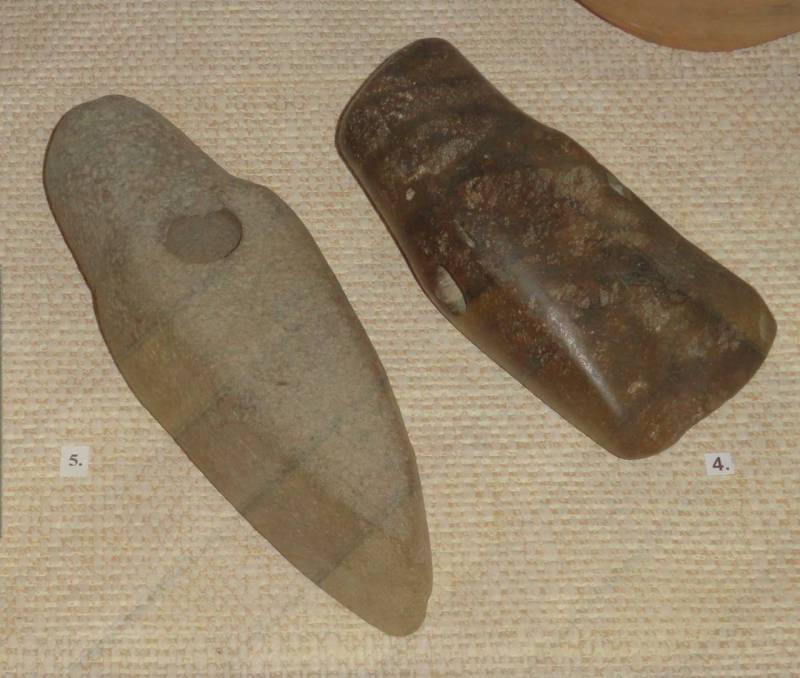
A typical splitting axe. Local Lore Museum of Pyatigorsk. Author's photo
On their basis, the Khvalynsk culture arose, which is also called “proto-kurgan”. Its representatives already knew how to process copper, and were also cattle breeders and horse breeders.
All these cultures in turn gave rise to the Yamnaya culture of the late Chalcolithic and early Bronze Age. Moreover, it was also a nomadic pastoralist, but with elements of hoe farming. Hoes were made from bones (horns). The “Yamniki” also knew how to make four-wheeled carts, the remains of which in Eastern Europe were found in the burial mounds of the Yamnaya culture (“Sentry grave” on the territory of the Dnieper, a burial ground near the village of Yasski in the Odessa region, the Shumaevsky burial ground in the Orenburg region, etc.) .
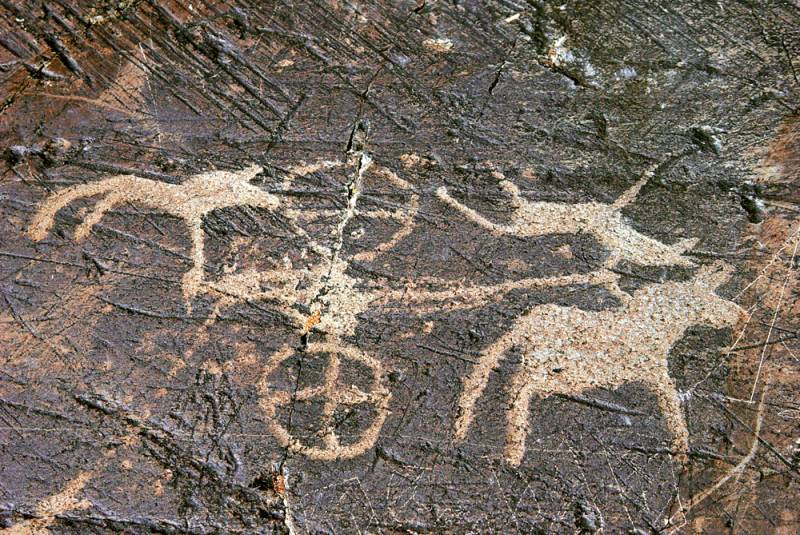
Image of an ancient chariot
The Yamniki buried their dead in pits over which they built a mound. Even animals were buried: cows, pigs, sheep, goats and horses. From the Danube in the west to the headwaters of the Manych River in the east, 160 burials of the Yamnaya culture were discovered, in which the remains of wheeled vehicles, clay models of carts and their images were found. Moreover, there are also remains of two-wheeled carts, which were clearly not vehicles.
Migrants and migrations
So what happens? And in the “pre-wheelie period” of their history, people constantly moved from place to place.
There is a lot of evidence that such movements took place both in the Paleolithic era and later, in the Mesolithic, and already in the Neolithic era they became, one might say, permanent. But…
The lack of transport made their travel rather slow, although, of course, people sailed along rivers and seas on rafts and boats, including reed boats.
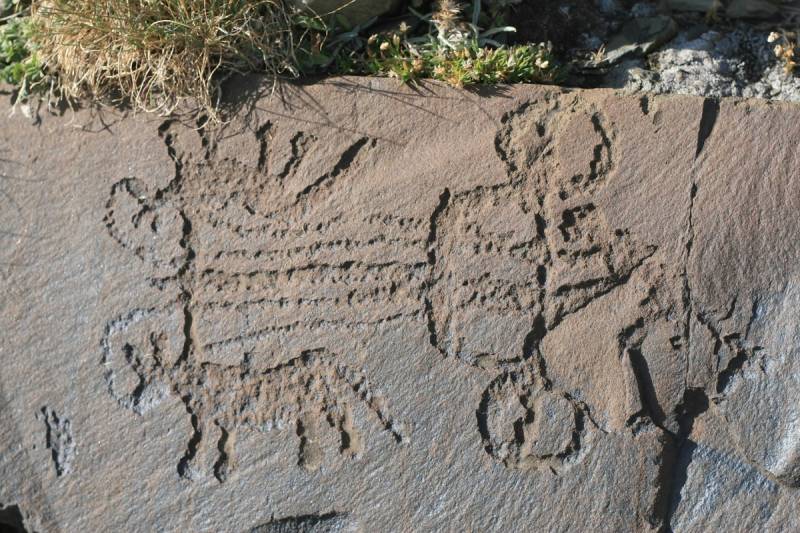
Chariots of Saimala-Tash
But in the steppes of Eastern Europe, people finally managed to domesticate the horse, came up with the wheel, a four-wheeled cart and a war chariot on two wheels and...
They immediately rolled at them in different directions! Moreover, some went west (“one of you will go to the West!”), while others, as if by agreement (“the other one will go to the Far East”), went east.
To a certain extent, they became cultural leaders among the peoples they met, as they brought with them horse breeding skills, cheekpieces, and introduced them to a unique type of transport - the horse-drawn carriage.
And the impression this made on the aborigines is evidenced by the images of these carts carved on rocks in different regions of Siberia.
Now the speed of migration has sharply accelerated, and accordingly the development of civilization as a whole has gained momentum!
To be continued ...
Information